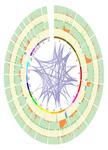版权所有:内蒙古大学图书馆 技术提供:维普资讯• 智图
内蒙古自治区呼和浩特市赛罕区大学西街235号 邮编: 010021

作者机构:Osaka Univ Cybermedia Ctr Toyonaka Osaka 560 Japan Univ Tokyo Res Ctr Complex Syst Biol Grad Sch Arts & Sci Tokyo Japan Univ Tokyo Dept Basic Sci Grad Sch Arts & Sci Tokyo Japan
出 版 物:《PLOS COMPUTATIONAL BIOLOGY》 (PLoS计算生物学)
年 卷 期:2013年第9卷第4期
页 面:e1003001-e1003001页
核心收录:
学科分类:0710[理学-生物学] 08[工学] 09[农学] 0901[农学-作物学] 0836[工学-生物工程] 090102[农学-作物遗传育种]
基 金:MEXT Japan [4103, 21120004] Japan Society for the Promotion of Science Grants-in-Aid for Scientific Research [10J05435, 21120004] Funding Source: KAKEN
主 题:GENE regulatory networks HOMEOSTASIS GENE expression DEGREES of freedom SACCHAROMYCES cerevisiae MICROARRAY technology
摘 要:Cells generally adapt to environmental changes by first exhibiting an immediate response and then gradually returning to their original state to achieve homeostasis. Although simple network motifs consisting of a few genes have been shown to exhibit such adaptive dynamics, they do not reflect the complexity of real cells, where the expression of a large number of genes activates or represses other genes, permitting adaptive behaviors. Here, we investigated the responses of gene regulatory networks containing many genes that have undergone numerical evolution to achieve high fitness due to the adaptive response of only a single target gene;this single target gene responds to changes in external inputs and later returns to basal levels. Despite setting a single target, most genes showed adaptive responses after evolution. Such adaptive dynamics were not due to common motifs within a few genes;even without such motifs, almost all genes showed adaptation, albeit sometimes partial adaptation, in the sense that expression levels did not always return to original levels. The genes split into two groups: genes in the first group exhibited an initial increase in expression and then returned to basal levels, while genes in the second group exhibited the opposite changes in expression. From this model, genes in the first group received positive input from other genes within the first group, but negative input from genes in the second group, and vice versa. Thus, the adaptation dynamics of genes from both groups were consolidated. This cooperative adaptive behavior was commonly observed if the number of genes involved was larger than the order of ten. These results have implications in the collective responses of gene expression networks in microarray measurements of yeast Saccharomyces cerevisiae and the significance to the biological homeostasis of systems with many components.